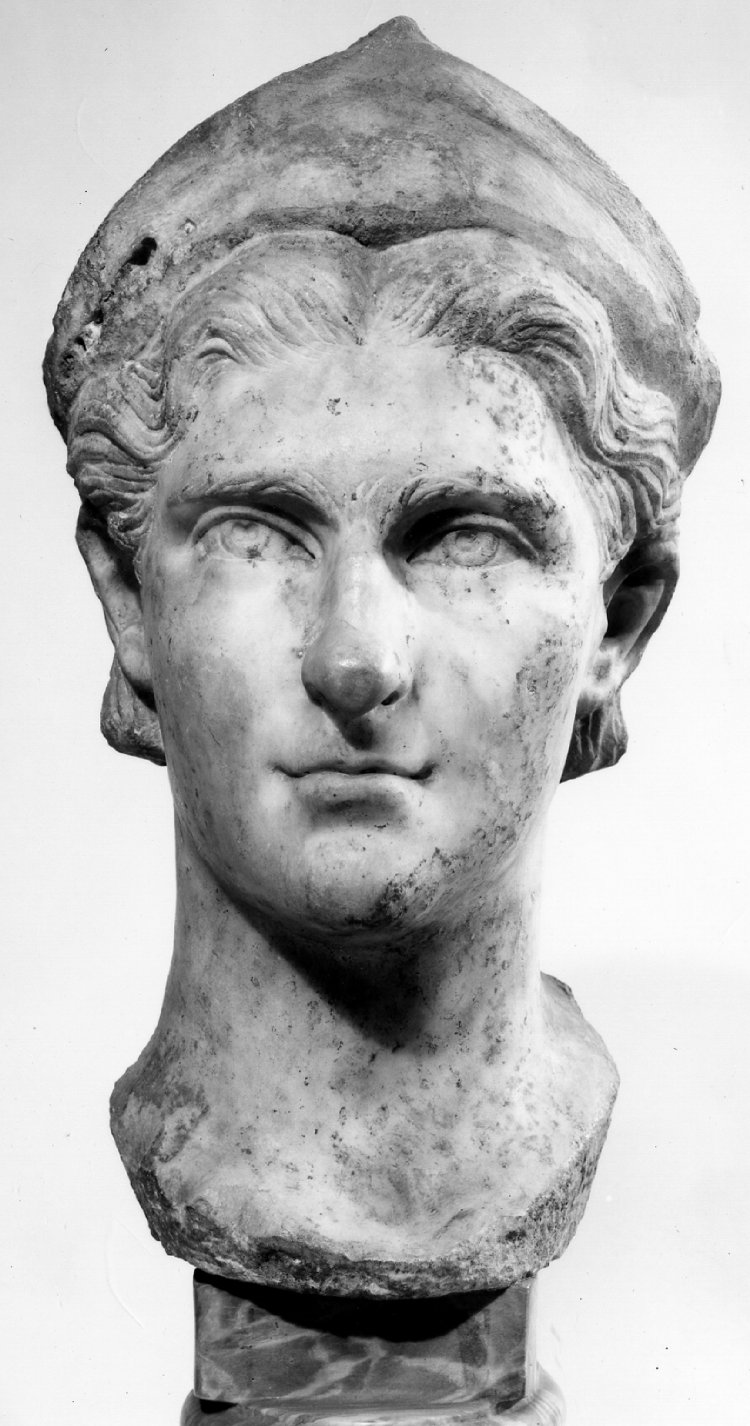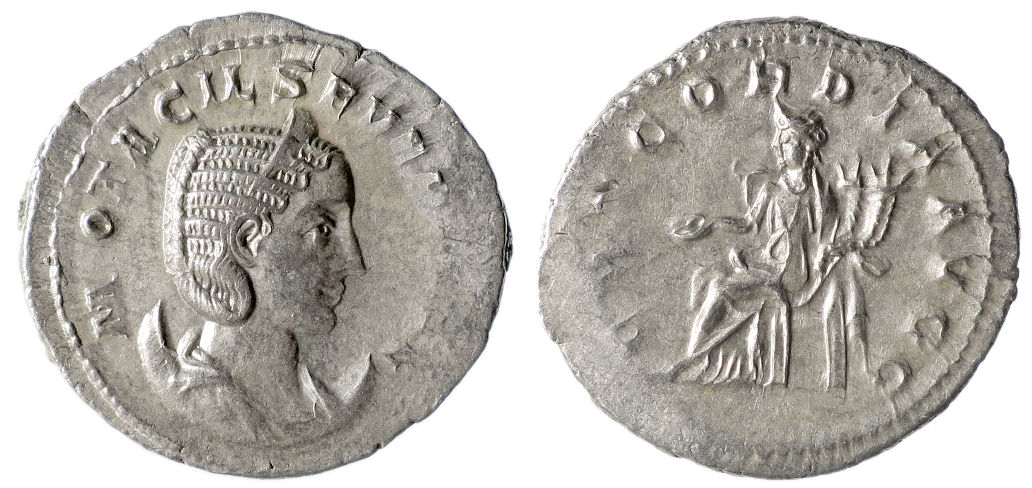|
Herennia Etruscilla
Herennia Cupressenia Etruscilla was an Augusta and later regent of the Roman Empire, married to Emperor Decius, and mother of Emperors Herennius Etruscus and Hostilian. She served as regent of the Roman Empire during the reign of her son Hostilian in 251. Life As with most third-century Roman empresses, very little is known about her. She was probably from a senatorial family. It is assumed that her ancestors settled in Etrurian lands. Herennia married Decius probably before 230 and gained the title Augusta when Decius became emperor 249. When Decius and Herennius were defeated and killed in the Battle of Abrittus in 251, she became regent during the minority of her thirteen-year-old son Hostilian. Hostilian died of the plague later that year, thus ending her mandate as regent. She sank into obscurity after her sons perished. While information about her is scarce, coins with her portrait are numerous and easy to obtain. Legends on coins struck at Rome only ever give her name as ... [...More Info...] [...Related Items...] OR: [Wikipedia] [Google] [Baidu] |
Augusta (honorific)
Augusta may refer to: Places Australia * Augusta, Western Australia Brasil * Rua Augusta (São Paulo) Canada * Augusta, Ontario * North Augusta, Ontario * Augusta Street (Hamilton, Ontario) France * Augusta Suessionum ("Augusta of the Suessii"), Soissons * Augusta Viromanduorum ("Augusta of the Viromandui"), Saint-Quentin Germany * Augusta Treverorum ("Augusta of the Treveri") or Trier * Augusta Vindelicorum ("Augusta of the Vindelici") or Augsburg Italy * Augusta, Sicily * Augusta Praetoria Salassorum ("Praetorian Augusta of the Salassi") or Aosta * Augusta Taurinorum ("Augusta of the Taurini") or Turin * Perugia or ''Augusta Perusia'' Spain * Emerita Augusta, Mérida, Spain * Caesar Augusta, Zaragoza, Spain United States * Augusta, Arkansas * Augusta Charter Township, Michigan * Augusta County, Virginia * Augusta, Georgia ** Augusta National Golf Club ("Augusta"), home of the Masters Tournament * Augusta, Illinois * Augusta, Indiana * Augusta, Indianapolis, Indiana * ... [...More Info...] [...Related Items...] OR: [Wikipedia] [Google] [Baidu] |
Cypress Tree
Cypress is a common name for various coniferous trees or shrubs of northern temperate regions that belong to the family Cupressaceae. The word ''cypress'' is derived from Old French ''cipres'', which was imported from Latin ''cypressus'', the latinisation of the Greek κυπάρισσος (''kyparissos''). Cypress trees are a large classification of conifers, encompassing the trees and shrubs from the cypress family (Cupressaceae) and many others with the word “cypress” in their common name. Many cypress trees have needle-like, evergreen foliage and acorn-like seed cones. Species Species that are commonly known as cypresses include: Most prominently: *Cypress (multiple species within the genus ''Cupressus'') Otherwise: *African cypress (''Widdringtonia'' species), native to Southern Africa *Bald, Pond, and Montezuma cypresses (''Taxodium'' species), native to North America *Chinese swamp cypress (''Glyptostrobus pensilis''), Vietnam, critically endangered *Cordilleran cyp ... [...More Info...] [...Related Items...] OR: [Wikipedia] [Google] [Baidu] |
Decian Dynasty
The Crisis of the Third Century, also known as the Military Anarchy or the Imperial Crisis (AD 235–284), was a period in which the Roman Empire The Roman Empire ( la, Imperium Romanum ; grc-gre, Βασιλεία τῶν Ῥωμαίων, Basileía tôn Rhōmaíōn) was the post-Republican period of ancient Rome. As a polity, it included large territorial holdings around the Mediterr ... nearly collapsed. The crisis ended due to the military victories of Aurelian and with the ascension of Diocletian and his implementation of reforms in 284, including the Tetrarchy. The crisis began in 235 with the assassination of Emperor Severus Alexander by his own troops. During the following 50-year period, the Empire saw the combined pressures of barbarian invasions and Human migration, migrations into the Roman territory, civil wars, bagaudae, peasant rebellions and political instability, with multiple Roman usurper, usurpers competing for power. This led to the debasement of Roma ... [...More Info...] [...Related Items...] OR: [Wikipedia] [Google] [Baidu] |
3rd-century Viceregal Rulers
The 3rd century was the period from 201 ( CCI) to 300 (CCC) Anno Domini (AD) or Common Era (CE) in the Julian calendar.. In this century, the Roman Empire saw a crisis, starting with the assassination of the Roman Emperor Severus Alexander in 235, plunging the empire into a period of economic troubles, barbarian incursions, political upheavals, civil wars, and the split of the Roman Empire through the Gallic Empire in the west and the Palmyrene Empire in the east, which all together threatened to destroy the Roman Empire in its entirety, but the reconquests of the seceded territories by Emperor Aurelian and the stabilization period under Emperor Diocletian due to the administrative strengthening of the empire caused an end to the crisis by 284. This crisis would also mark the beginning of Late Antiquity. In Persia, the Parthian Empire was succeeded by the Sassanid Empire in 224 after Ardashir I defeated and killed Artabanus V during the Battle of Hormozdgan. The Sassanids the ... [...More Info...] [...Related Items...] OR: [Wikipedia] [Google] [Baidu] |
3rd-century Roman Empresses
The 3rd century was the period from 201 ( CCI) to 300 (CCC) Anno Domini (AD) or Common Era (CE) in the Julian calendar.. In this century, the Roman Empire saw a crisis, starting with the assassination of the Roman Emperor Severus Alexander in 235, plunging the empire into a period of economic troubles, barbarian incursions, political upheavals, civil wars, and the split of the Roman Empire through the Gallic Empire in the west and the Palmyrene Empire in the east, which all together threatened to destroy the Roman Empire in its entirety, but the reconquests of the seceded territories by Emperor Aurelian and the stabilization period under Emperor Diocletian due to the administrative strengthening of the empire caused an end to the crisis by 284. This crisis would also mark the beginning of Late Antiquity. In Persia, the Parthian Empire was succeeded by the Sassanid Empire in 224 after Ardashir I defeated and killed Artabanus V during the Battle of Hormozdgan. The Sassanids the ... [...More Info...] [...Related Items...] OR: [Wikipedia] [Google] [Baidu] |
Cornelia Salonina
Publica Licinia Julia Cornelia Salonina (died 268, Mediolanum) was an '' Augusta'' of the Roman Empire, married to Roman Emperor Gallienus and mother of Valerian II, Saloninus, and Marinianus. Life Julia Cornelia Salonina's origin is unknown. One modern theory is that she was born of Greek origin in Bithynia, then part of the province of Bithynia et Pontus, Asia Minor. However, there exists some scepticism on that. She married Gallienus about ten years before his accession to the throne. When her husband became joint-emperor with his father Valerian in 253, Cornelia Salonina was named ''Augusta''. Cornelia was the mother of three princes, Valerian II, Saloninus and Marinianus. Her fate after Gallienus was murdered during the siege of Mediolanum in 268 is unknown. One theory is that her life was spared; another is that she was executed together with other members of her family, at the orders of the Senate of Rome.Alaric Watson, ''Aurelian and the Third Century'', (Oxford: Rout ... [...More Info...] [...Related Items...] OR: [Wikipedia] [Google] [Baidu] |
Nonia Celsa
Nonia Celsa is the name given by the ''Historia Augusta'' to the wife of Roman Emperor Macrinus (and presumed mother of his son and co-emperor Diadumenian), who ruled briefly in 217–218. The name is regarded as highly dubious by modern historians. Life The only evidence of her existence is a happy letter allegedly written by Macrinus to his wife after he became Emperor. The first line is as follows: "Opellius Macrinus to his wife Nonia Celsa. The good fortune to which we have attained, my dear wife, is incalculable." The letter can be found in the biography of Diadumenian, part of a collection called ''Historia Augusta''. Such "documents" are generally considered fabrications and the biographer(s) is also infamous for inventing people and names. Without further evidence even the existence of Nonia Celsa is highly dubious. The ''Historia Augusta'' also claims that her son Diadumenian got his name from his maternal grandfather, which prompted Anthony R. Birley to identify her po ... [...More Info...] [...Related Items...] OR: [Wikipedia] [Google] [Baidu] |
Cornelia Supera
Gaia Cornelia Supera (died after 253 AD) was the empress of Rome and the wife of Roman Emperor, Emperor Aemilian. Nothing is known about her life, except from numismatic evidence. Her full name on the coins is C[AIA] CORNEL[IA] SVPERA AVG[VSTA], or alternatively CORNEL[IA] SVPERA AVG[VSTA] or COR[NELIA] SVPERA AV[GVSTA]. Her coins are extremely rare. Her name and monuments were condemned after Valerian (emperor), Valerian was hailed as emperor in October of 253. References {{DEFAULTSORT:Supera, Cornelia 3rd-century Roman empresses Crisis of the Third Century Cornelii Augustae ... [...More Info...] [...Related Items...] OR: [Wikipedia] [Google] [Baidu] |
Afinia Gemina Baebiana
Afinia Gemina Baebiana was the wife of Roman Emperor Trebonianus Gallus, who ruled briefly in 251–253. Almost nothing is known about her life. She had two children, Volusianus and a daughter, Vibia Galla. After Trebonianus Gallus was proclaimed emperor by the soldiers, Herennia Etruscilla, widow of Emperor Decius Gaius Messius Quintus Traianus Decius ( 201 ADJune 251 AD), sometimes translated as Trajan Decius or Decius, was the emperor of the Roman Empire from 249 to 251. A distinguished politician during the reign of Philip the Arab, Decius was procla ..., was allowed to keep the honorary title ''Augusta''. Afinia Gemina Baebiana never was afforded the title and there are no coins of her either. Forum Ancient Coins Her husband and son were murdered by soldiers in AD 253. Refe ...
|
Empress Of Rome
This is a list of Roman and Byzantine empresses. A Roman empress was a woman who was the wife of a Roman emperor, the ruler of the Roman Empire. The Romans had no single term for the position: Latin and Greek titles such as '' augusta'' (Greek αὐγούστα, ''augoústa'', the female form of the honorific ''augustus'', a title derived from the name of the first emperor, Augustus), ''caesarea'' (Greek καισᾰ́ρειᾰ, ''kaisáreia'', the female form of the honorific ''caesar'', a title derived from the name of Julius Caesar), βᾰσῐ́λῐσσᾰ (''basílissa'', the female form of ''basileus''), and ''αὐτοκράτειρα'' (''autokráteira,'' Latin ''autocratrix'', the female form of autocrator), were all used. In the third century, ''augustae'' could also receive the titles of ''māter castrōrum'' "mother of the castra" and ''māter patriae'' "mother of the fatherland". Another title of the Byzantine empresses was εὐσεβέστᾰτη αὐγούσ� ... [...More Info...] [...Related Items...] OR: [Wikipedia] [Google] [Baidu] |
Marcia Otacilia Severa
Marcia Otacilia Severa was the Empress of Rome and wife of Emperor Philip the Arab, who reigned over the Roman Empire from 244 to 249. Biography Early life She was a member of the ancient gens Otacilia, of consular and senatorial rank. Her father was Otacilius Severus or Severianus, who served as Roman Governor of Macedonia and Moesia, while her mother was either a member of or related to the gens Marcia. According to sources she had a brother called Severianus, who served as Roman Governor of Lower Moesia in 246–247. Marriage In 234, Severa married Philip who at that time probably served in the Praetorian Guard under Emperor Alexander Severus and they had at least one child, Marcus Iulius Philippus Severus or Philippus II (born in 238), who later became co-emperor with his father. In February 244, the emperor Gordianus died in Mesopotamia, it is suspected in the sources that he was murdered, and there is a possibility that Severa was involved in the conspiracy. Her h ... [...More Info...] [...Related Items...] OR: [Wikipedia] [Google] [Baidu] |





